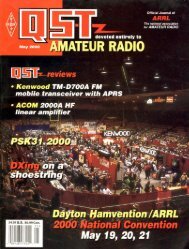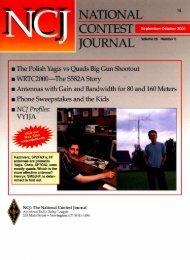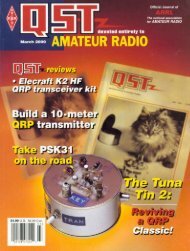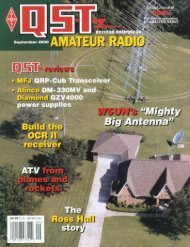Create successful ePaper yourself
Turn your PDF publications into a flip-book with our unique Google optimized e-Paper software.
By Shelby Ennis, W8WN<br />
Utilizing the Constant<br />
Bombardment of Cosmic Debris<br />
for Routine Communication<br />
Thanks to sophisticated software and high-speed CW (HSCW), you can make<br />
meteor-scatter QSOs on just about any (and every) day of the year. SSB may reign<br />
supreme during meteor showers, but HSCW has made its way from Europe and is<br />
now alive and well in North America.<br />
Confidential:<br />
“Your mission, Mr. Phelps, should you<br />
choose to accept it, is to complete a contact<br />
on 144 MHz over a 600-1000 mile (960-<br />
1610 km) path in less than 20 minutes every<br />
morning of the year while developing<br />
techniques to help others do the same. As<br />
always, should you or members of your<br />
2-m force fail, the Secretary will disavow<br />
any knowledge of your operation. It is<br />
suggested that you recruit a top-notch team<br />
for this operation. This tape will selfdestruct<br />
in 15 seconds. Good luck.”<br />
Report—For Eyes Only:<br />
“Mr Secretary: After a slow start, we are<br />
now approaching the goal. Between January<br />
1999 and April <strong>2000</strong>, 172 out of 215 144-<br />
MHz schedules were completed with K0XP,<br />
for an 80% completion rate, usually within<br />
15 minutes, over an 813-mile (1308 km)<br />
path, which included schedules during the<br />
poorest time of the year.<br />
During the period of February through<br />
April <strong>2000</strong>, 21 of 22 attempts were also<br />
completed with K1JT on 144 MHz, and 11<br />
of 11 were completed on 50 MHz over a 650-<br />
mile (1050 km) path. Details to follow.”<br />
While the above might sound like an<br />
opening scene from a Mission Impossible<br />
episode, it’s actually is a brief summary of<br />
what’s been happening during the past three<br />
years. Long-distance 144-MHz contacts<br />
have become so routine that we’re now<br />
surprised when a schedule isn’t successful.<br />
Exotic propagation modes and satellites<br />
aren’t even in the picture. What we’re using<br />
28 <strong>November</strong> <strong>2000</strong><br />
is a modern variation of 1950’s ham<br />
technology—meteor scatter.<br />
A Brief History of<br />
Meteor Scatter Operation<br />
Meteor-scatter operation began in 1953<br />
when Paul Wilson, W4HHK, 1 (in western<br />
Tennessee), and Ross Bateman, W4AO<br />
(northeastern Virginia), kept hearing signal<br />
bursts while trying to work during a<br />
widespread tropospheric opening. They,<br />
along with W2UK, W5RCI, W2NLY,<br />
W2AZL, W1HDQ, W1FZJ and others were<br />
soon running tests to determine how<br />
communication could be accomplished<br />
using this mode. 2,3<br />
With the publication of two <strong>QST</strong> articles<br />
by Walt Bain, W4LTU, 4,5 meteor scatter soon<br />
became a popular mode for making contacts<br />
beyond the normal extended-tropo range.<br />
1 Notes appear on page 32.<br />
During the annual Perseids meteor shower,<br />
although stations were spread out, enough<br />
were active that QRM became a problem at<br />
times. (Everyone was crystal-controlled and<br />
there was no way to use a calling frequency<br />
in those days). Using various keying methods<br />
and multi-speed reel-to-reel tape recorders,<br />
some ops managed to work at speeds of up<br />
to 100 WPM (slowing the tape for copying).<br />
Most of the time the “pings” were few<br />
and short. As SSB operation became more<br />
common on VHF in the 1970s, North<br />
American hams were able to exchange more<br />
information in the same amount of time, but<br />
SSB operation still required pings of one<br />
second or longer to be really useful. On 144<br />
MHz, these seldom occurred except during<br />
major meteor showers. (On 50 MHz, where<br />
pings are longer, SSB MS contacts are<br />
routine for well-equipped stations.) Nearly<br />
all North American 144-MHz meteor<br />
scatter operation occurred only during the<br />
“big three” meteor showers each year (the<br />
August Perseids, December Geminids and<br />
January Quadrantids).<br />
Meanwhile, the Europeans developed a<br />
different approach. SSB meteor-scatter<br />
operation was still much too slow to utilize<br />
the barrage of tiny meteors that constantly<br />
strike the earth’s protective atmosphere.<br />
These pings, while numerous, are usually<br />
weak and very short. The Europeans sent<br />
CW at very high speeds using electronic<br />
keyers, and recorded incoming pings on<br />
modified audio cassette recorders that could<br />
be played back at a readable speed.<br />
This was a brilliant solution. Using this

















